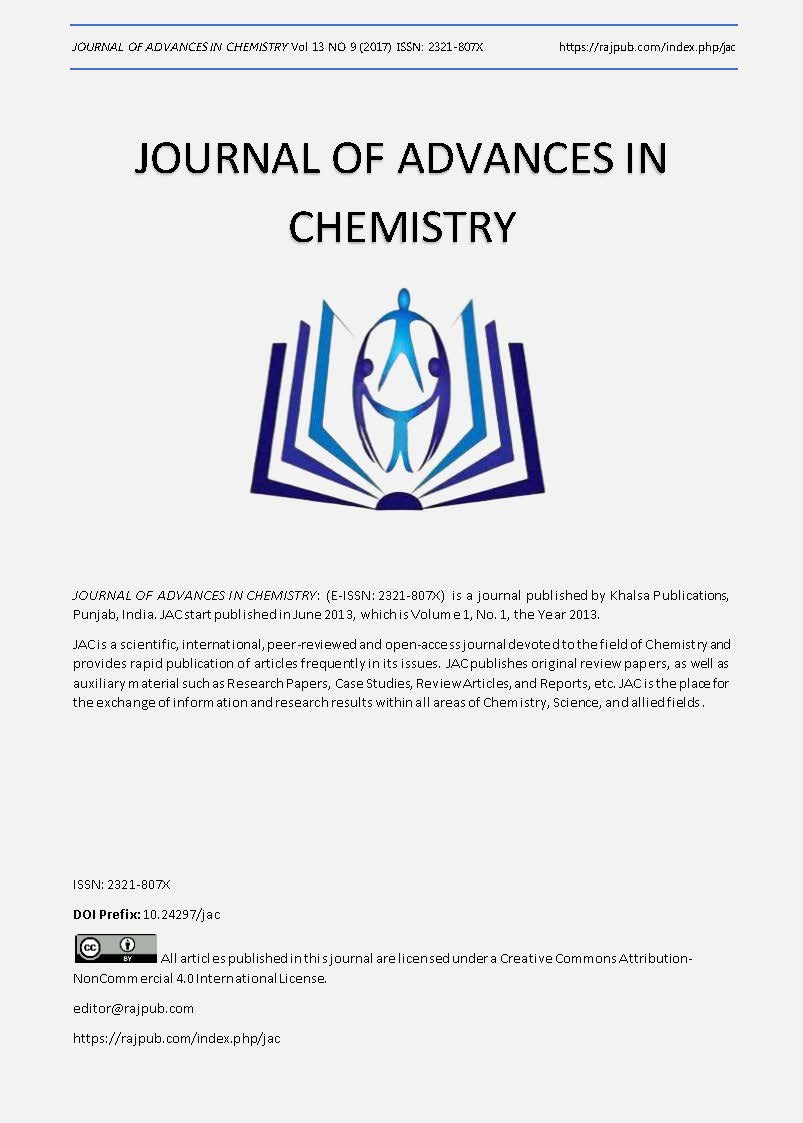Synthesis, spectral characterization and some biological studies of transition metal complexes with Schiff base ligand containing N,O and S as donor atoms
DOI:
https://doi.org/10.24297/jac.v13i9.5733Keywords:
Schiff base, metal complexes, antimicrobial activity, antifungal activity, DNA cleavageAbstract
Transition metal complexes of Cu(II), Co(II), Ni(II), Zn(II), Cd(II) and Mn(II) have been synthesized with the Schiff base ligand 5-Sub-N-(2-mercaptophenyl)salicylideneimine. Elemental analysis of these complexes suggest that these metal ions forms complexes of type ML(H2O)stoichiometry for Cu(II), Co(II), Ni(II), Zn(II), Cd(II) and Mn(II). The ligand behaves as tridentate and forms coordinate bonds through O, S and N atoms. Magnetic susceptibility, IR, UV – Visible, Mass and ESR spectral studies suggest that Cu(II), Ni(II) complexes posses square planar geometry, whereas Co(II), Zn(II), Cd(II) and Mn(II) complexes posses tetrahedral geometry. The complexes were tested for their antimicrobial activity against the bacterial strains Staphylococcus aureus and Bacillus subtilis.The Schiff base metal complexes evaluated for their antifungal activity against the fungi A. niger and C. oxysporum. The DNA cleavage studies of Schiff base complexes werestudied using Calf – Thymus DNA by agarose gel electrophoresis method.
Downloads
References
2. Ashok Kumar Yadava, Hardeo Singh Yadav, Rajul Saxena and Devendra Pratap Rao, Eur. Chem.Bull., Section A, 4 (2015), 356-359.
3. A. Maria Kulandai Raja Balan, R. Francis Nicholas Ashok, M. Vasanthi, R. Prabu and A. Paulraj, Int. J.Life Sciences Pharmaceutical Research, 3(2013), L-67 to L-75.
4. Anita Sharma, Tushar Mehta and Manish. K. Shah, Pelagia Research Library, 4(2013), 141-146.
5. Bushra Maliha, Ishtiaq.Hussain, Muhammad Ilyas Tariq, Hamid Latif Siddiqui, J. Chem. Soc. Pakistan, 31 (2009),829-837.
6. Mark J.Carter, D.Paul Rillema, Fred Basolo, Journal of Amer. Chem. Soc., 96 (1974), 392- 400.
7. A.P.Mishra, R.K.Mishra and S.P.Shrivastava, J.Serbian Chemical Society, 74(5) (2009), 523-535.
8. Razak Gafoor Sab, Fazlur Rahamann and B.H.M.Mrythyunjayaswamy, JOAC, 3(3) (2014)1246-1259.
9. P.Muthuselvan, S.Theodore David, M.Sivasankaran Nair, Asian J. Res. Chem.,4(8) (2011),1305-1310.
10. Gomathi, V and Selvameena R, Int.J.Recent Scientific Res., 4(1) (2013),94-97.
11. Y. Prashanthi, K. Kiranmaj, N.J.P. Subhashini, Shivaraj, Spectrochimica Acta Part A 70(1) (2008), 30-35.
12. Ramesh. S. Yamgar, Y. Nivid, Satish Nalawade, Mustapha Mandewale, R.G. Atram, and Sudhir.S. Sawant, Hindawi Publishing Corporation, Bioinorg. Chem. Applic., Article ID 276598 (2014), 1-10.
13. T. Mangamamga, M.C. Ganorkar and G. Swarnabala, Hindawi Publishing Corporation, Int. J. Inorg. Chem., 2014 (2014), 1-22.
14. Sandya Rani, Badekai Ramachandra Bhat, Inorg. Chem. Comm.,13 (2010), 1289-1292.
15. A.P.Gingsberg, Inorg. Chim. Act. Revs.,5 (1971), 45-68.
16. Jian – ning LIU, Bo – Wan WU, Bing ZHANG, Yongchun LIU,Turk J. Chem., Vol.30, pp 41-48, 2006.
17. Rekha S. Hunoor, Basavaraj R. Patil, Dayananada S. Badiger, Ramesh S. Vadavi, Kalagouda B. Gudasi, V.M. Chandrashekhar, I.S. Muchchandi, Spect. Acta. Part A 77 (2010), 838-844.
18. A.P. Mishra and Annapoorna Tiwari, J. Ind. Council of Chemists, 28(1) (2011), 01-07.
19. S. Priya, J. Senthil Kumaran, N. Jayachandramani and S. Mahalakshmi, Am. J. Pharmtech. Res.,3(3) (2013), 607-616.
20. S.Pattanaik, S.S.Rout, J.Panda, P.K.Sahu and M. Banerjee, Rasayan J. of Chem,4(1) (2011), 136-141.
21. Khurram Shoaib, Wajid Rehman, bakhtiar Mohammad and Sadiq Ali, J. Proteomics Bioinform., 6(7) (2013), 153-157.
22. Pritha Talukder, Amitabha Datta, Samiran Mitra and Georgina Rosair, Z. Naturforsch, 59 b (2004), 655-660.
23. Yiheyis Bogale Zemede, Nithyakalyani D, Ananda Kumar S, International Journal of Chemtech Research, 6(11) (2014), 4569 – 4578.
24. Mahmoud Najim AL-Jibouri, Fadhil R. Hafidh and Anaam Majeed Rasheed, Eur. Chem. Bull., 3(6) (2014), 559-562.
25. Abdul Salam A.K. Abdul Rahman, Diala, Jour,39 (2009), 133-141.
26. Tudor Rosu, Elena Pahontu, Calatin Maxim, Rodica Georgescu, Nicolae Stanica, Gabriela Laura Almajan, Aurelian Gulea, Polyhedron,29 (2010), 757-766.
27. M.Revanasiddappa, C.Basavaraja, T.Suresh and S.D.Angadi, Journal of Indian Chemical Society, 86 (2009),127-132.
28. Bibhesh K. Singh, Anant Prakash, Hemant K. Rajour, Narendra Bhojak, Devjani Adhikari, Spectrochimica Acta Part A 76 (2010), 376-383.
29. Abdalla M. Khedr, Hadi M. Marwani, Int. J. Electrochem. Sci.,7 (2012), 10074 – 10093.
30. Sangamesh A. Patil, Shrishila N.Unki, Ajaykumar D.Kulkarni, Vinod H.Naik, Prema S.Badami, Spectrochimica Acta Part A: Molecular and Biomolecular Spectroscopy, 79(5) (2011),1128-1136.
31. M.O. Agwara, N.B. Ndosiri, A. Mohamadou and A.M. Conde, Research Journal of Pharmaceutical, Biological and Chemical Sciences, 4 (2013), 1370-1381.
32. Aldou Saad El-Tabl, Moshira Mohamed Abd El-Waheed, Mohammed Ahmed Wahba and Nahla Abd El-Halim Abou El-Fadl, Hindawi Publishing Corporation, Bioinorganic Chemistry and Applications, 2015, Article ID 126023 (2015), 1-14.
33. M.B.Halli, Naghma Shaishta, Sadu Suryakant.S and K.Mallikarjun,Journal of Applicable Chemistry, 3(4) (2014), 1543-1551.
34. Sambrook, J., Fritsch, E.F. and Maniatis, T. (1989) Molecular cloning, A laboratory Manual. 2nd Edn. Cold Spring Harbor Laboratory, Cold Spring Harbor, New York.
35. Samir Alghool, Hanan F.Abd El-Halim, A.Dahshan, Journal of Molecular Structure, 983 (2010),32-38.
36. M.B.Fugu, N.P.Ndahi, B.B.Paul and A.N.Mustapha, Journal of Chemical and Pharmaceutical Research, 5(4) (2013), 22-28.
37. Vijay Kumar Tirlapur and Kashinath Noubade, Asian Journal of Research in Chemistry, Vol.3(3) (2010), 659-662.
38. Monika Kumawat and Ganpat L.Talesara, Journal of Applicablechemistry,2(4) (2013),754-764.
Additional Files
Published
How to Cite
Issue
Section
License
 All articles published in Journal of Advances in Linguistics are licensed under a Creative Commons Attribution 4.0 International License.
All articles published in Journal of Advances in Linguistics are licensed under a Creative Commons Attribution 4.0 International License.




